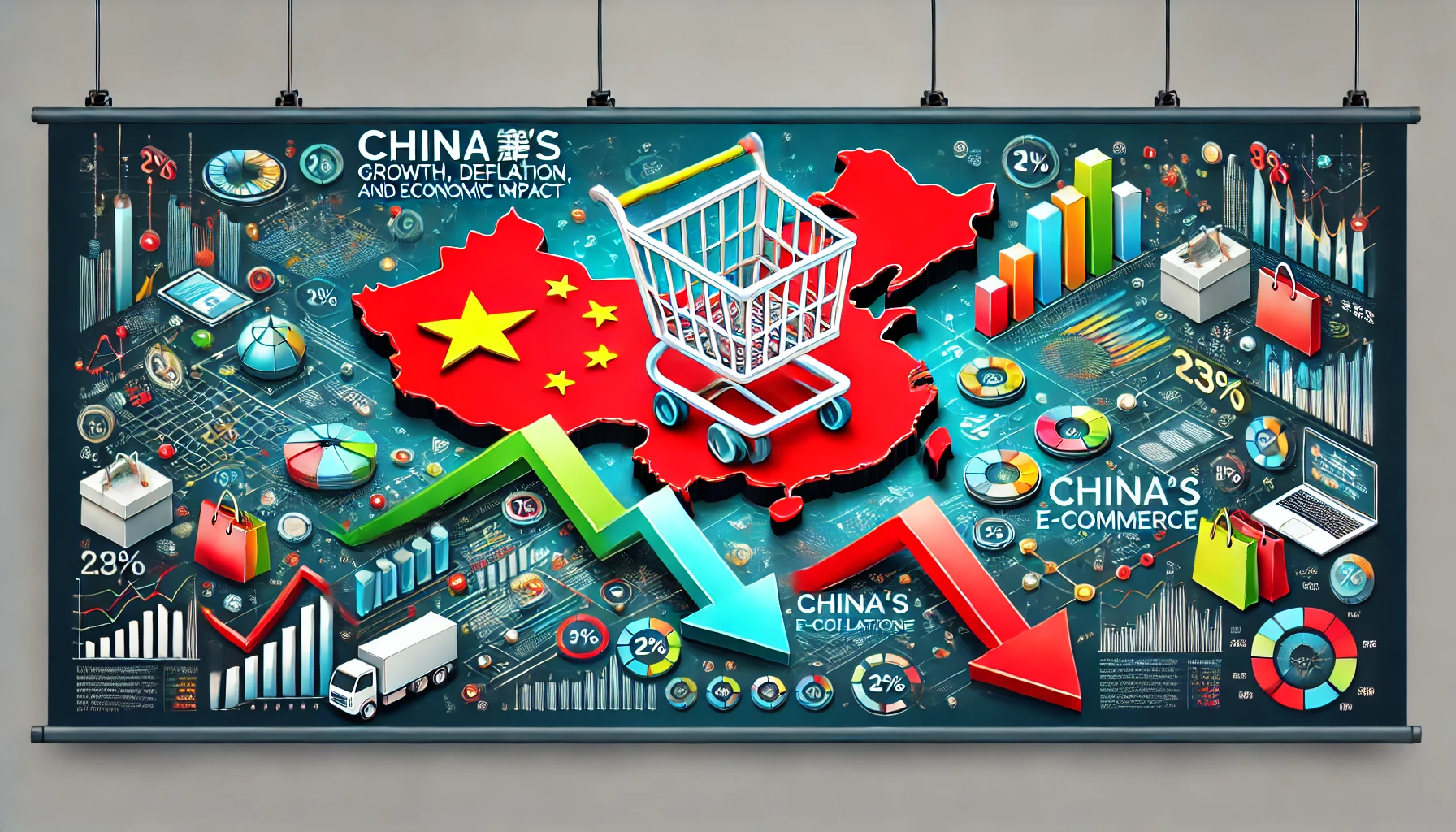How E-Commerce Growth Is Reshaping China’s Economy Amid Deflationary Trends
China’s economy has long been a subject of global fascination, with its rapid industrialization, technological advancements, and growing influence on the world stage. However, in recent years, China has faced an economic slowdown, marked by complex challenges such as inflation and deflationary pressures. One of the surprising contributors to these economic shifts is the explosive growth of e-commerce in China, which is simultaneously driving consumer behavior and adding to the country’s deflationary woes. As e-commerce reshapes the retail economy and alters consumer prices, it’s essential to understand the dual impact on the economy.
In this blog, we will explore the interconnected relationship between China’s e-commerce sector, its broader economic slowdown, and the rise of deflationary pressure in China. We’ll dive into how e-commerce growth is changing consumer prices, reshaping the retail economy, and influencing China’s battle between inflation and deflation.
The Rise of E-Commerce in China
E-Commerce Growth in China: A Digital Revolution
Over the past decade, e-commerce growth in China has skyrocketed, becoming one of the world’s most advanced and competitive online markets. Platforms like Alibaba, JD.com, and Pinduoduo dominate the digital marketplace, attracting millions of consumers with their wide range of products, competitive pricing, and rapid delivery services. The sheer scale of China’s e-commerce is staggering. In 2023, China’s e-commerce market surpassed $2 trillion, accounting for over 50% of global online retail sales(Semrush).
This e-commerce growth has been driven by a variety of factors, including high internet penetration rates, the rise of mobile payment systems like Alipay and WeChat Pay, and a tech-savvy population eager to embrace digital commerce. As more consumers turn to online shopping, traditional brick-and-mortar stores are facing increased competition, leading to price wars that often favor online retailers.
E-Commerce’s Impact on China’s Retail Economy
The rapid expansion of e-commerce in China has had a profound impact on the retail economy. Traditional retailers are struggling to keep up with the convenience and pricing power of online giants, leading to store closures, consolidation, and shifts in consumer spending patterns. In particular, China online retail sales have contributed significantly to the country’s overall retail revenue, with online sales now accounting for more than 30% of total retail sales(Semrush)(StorePlum).
This shift toward e-commerce has transformed how goods are bought and sold, especially in urban areas where digital commerce is a primary method of purchasing everything from groceries to luxury goods. However, this transformation is not without its downsides, particularly as it contributes to deflationary pressures in the economy.
Deflationary Pressures in China
What Is Deflation and Why Is It a Concern in China?
Deflation occurs when the general price level of goods and services falls over time, reducing consumer spending and slowing economic growth. While a moderate level of deflation might seem beneficial for consumers as prices decrease, prolonged deflation can be damaging. It can lead to reduced consumer confidence, lower corporate profits, wage stagnation, and an overall economic downturn.
In recent years, deflationary pressure in China has grown due to a combination of factors, including excess industrial capacity, a slowing real estate market, and, notably, the price-cutting pressures driven by e-commerce(Hypotenuse AI)(Gelato). The China economic slowdown, exacerbated by the COVID-19 pandemic, has intensified these challenges, leading to declining consumer prices in certain sectors.
E-Commerce and Deflation: A Complex Relationship
E-commerce has been a double-edged sword for China’s economy. On the one hand, it has boosted consumption and helped sustain growth by providing consumers with cheaper goods and greater variety. On the other hand, the intense competition among e-commerce platforms has driven prices down, contributing to China deflation concerns.
Many online retailers operate on razor-thin profit margins and rely heavily on discounts, flash sales, and bulk buying to attract consumers. As a result, consumer prices for many goods, particularly electronics, clothing, and household items, have fallen significantly(Semrush). This price-cutting culture, while beneficial for consumers, has put pressure on manufacturers and traditional retailers to lower their prices as well, creating a cycle of deflationary pricing.
Inflation vs Deflation: China’s Economic Balancing Act
China has been grappling with a delicate balance between inflation and deflation. In some sectors, inflationary pressures, such as rising housing costs, continue to be a concern, while in other sectors, particularly consumer goods and retail, deflation has taken hold(Hypotenuse AI)(StorePlum). This has created a complex economic environment in which the government must carefully manage monetary policy to avoid tipping the scales too far in either direction.
The government has implemented various measures to stimulate demand and combat deflation, including tax cuts, subsidies, and infrastructure investment. However, these efforts have been somewhat offset by the downward pricing pressures of the e-commerce market.
The Future of China’s Retail Economy
China Consumer Prices: Where Are They Headed?
As China consumer prices continue to fluctuate, there is growing concern that prolonged deflation could harm economic recovery efforts. China’s retail economy has shown signs of resilience, particularly as urban populations embrace online shopping. However, the deflationary impact of e-commerce is likely to persist, especially as platforms continue to compete fiercely for market share.
To stabilize consumer prices, the government may need to intervene with stronger regulatory oversight of online retailers, ensuring that price competition does not spiral into a deflationary trap. Additionally, encouraging traditional retailers to innovate and integrate with e-commerce platforms could help balance the playing field and protect against further price drops(Semrush).
China Online Retail Sales: A Long-Term Driver of Growth?
Despite the challenges posed by deflation, China online retail sales are expected to continue growing, driven by increased consumer demand for convenience, variety, and lower prices. The growth of e-commerce is unlikely to slow down anytime soon, with analysts predicting that online retail will account for an even larger share of total retail sales in the coming years(StorePlum).
The challenge for China’s policymakers will be to harness the positive aspects of e-commerce growth while mitigating its deflationary effects on the broader economy. This could involve supporting smaller retailers and encouraging sustainable pricing strategies across the industry.
E-Commerce’s Role in China’s Economic Transformation
In conclusion, e-commerce growth in China is reshaping the retail economy, driving consumer prices lower, and contributing to both the country’s economic transformation and its deflationary challenges. As China navigates the complex interplay between inflation and deflation, it must balance the benefits of a booming e-commerce sector with the need to stabilize prices and promote sustainable economic growth.
E-commerce will undoubtedly continue to play a critical role in China’s economic future, but the country must be mindful of how deflationary trends could hamper long-term progress. For a deeper dive into how economic forces shape markets, check out Regent Studies for insights into global economic trends and their impacts.
For further reading on the intricacies of China’s economic landscape, you can explore this analysis from Bloomberg.



